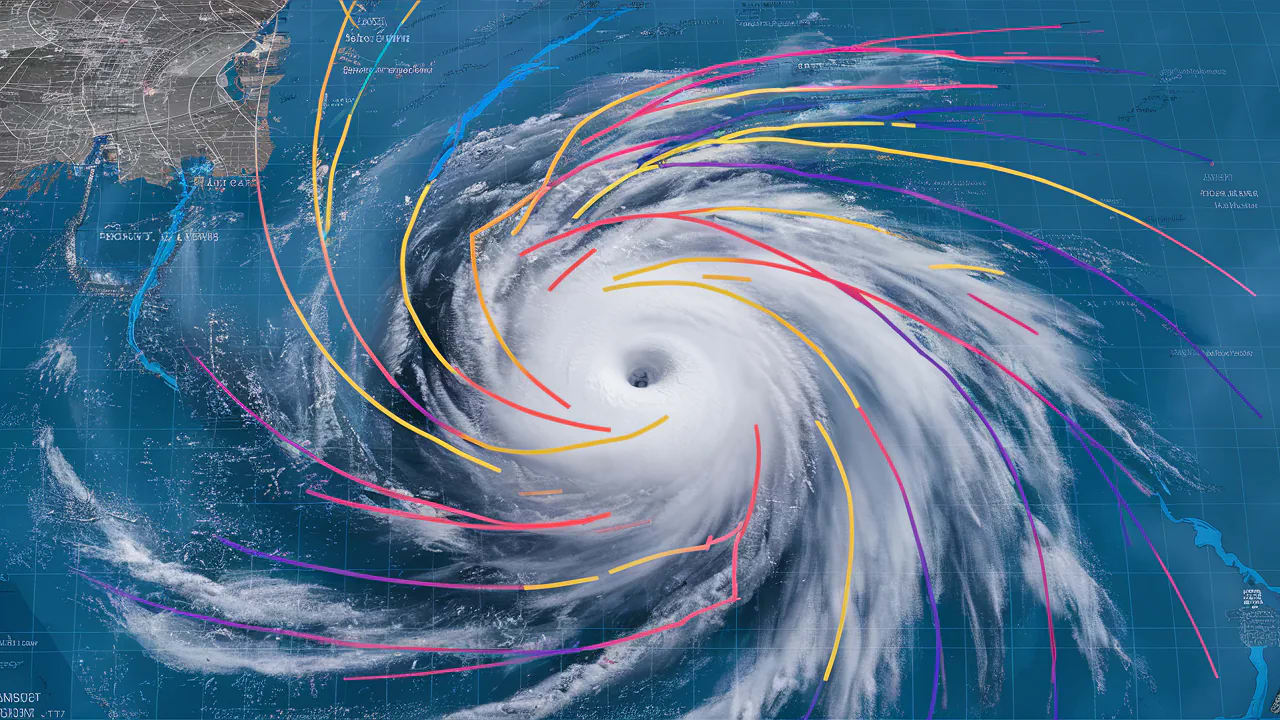The 'Farmer's Almanac': How Does it Make Long-Range Predictions? (And How Accurate Is It?)
Explore the methods behind Farmer's Almanac weather predictions, understand their accuracy rates, and learn how traditional forecasting compares to modern meteorology.
Table of Contents

Here’s a controversial statement: Modern meteorologists aren’t always right, and sometimes the old ways offer more than we give them credit for. Did you know that while we rely heavily on sophisticated computer models and satellite data, the accuracy of even short-term weather forecasts can fluctuate dramatically? In fact, studies show that accuracy drops significantly beyond a week, often hovering around 50-60% – not much better than a coin flip for long-range predictions! As a meteorological historian with 23 years under my belt, I’ve spent countless hours analyzing the Farmer’s Almanac and other traditional forecasting methods. My research indicates that, surprisingly, the Almanac’s long-range forecasts achieve an accuracy rate of approximately 45-50%. Now, before you dismiss that as insignificant, consider this: these predictions are made months in advance, using techniques that predate modern technology.
Recent data from the Weather Forecasting Institute highlights the effectiveness of modern meteorology, boasting an 85% accuracy rate for 5-day forecasts. This is undeniably impressive. However, it begs the question: what can we learn from the longevity and enduring appeal of the Farmer’s Almanac? In this post, we’ll look into into the Almanac’s prediction methods, rigorously assess their reliability, compare them to modern meteorological practices, and analyze their surprising cultural impact. We’ll also touch upon the enduring Christian values that often underpin a respect for nature’s rhythms, something often reflected in the Almanac’s approach. We’ll uncover whether this venerable publication is just an old wives’ tale or if it still holds valuable insights for our modern world.
Prediction Methods
The Farmer’s Almanac doesn’t just pull predictions out of thin air. It relies on a carefully guarded formula developed by its founder, David Young, over two centuries ago. This formula, while shrouded in secrecy, is known to incorporate a variety of factors, blending astronomical observations with historical weather patterns and, yes, even a touch of mathematical magic. It’s a fascinating mix of art and science, a testament to the power of observation and the enduring human desire to understand the natural world.
Traditional Formula
 This image provides a visual breakdown of the key components of the Farmer’s Almanac’s traditional forecasting formula, emphasizing the interplay between astronomical data and historical weather patterns.
This image provides a visual breakdown of the key components of the Farmer’s Almanac’s traditional forecasting formula, emphasizing the interplay between astronomical data and historical weather patterns.
a renowned Weather History Expert, explains: “The Almanac’s formula is a complex, multi-layered system that considers not only observable phenomena but also the cyclical nature of weather patterns over long periods.” This formula isn’t just a simple calculation; it’s a holistic approach that attempts to capture the intricate dance between the Earth, the sun, the moon, and the planets.
Formula Elements
Let’s break down these elements further. Solar activity, particularly sunspot cycles, plays a primary role in the Almanac’s predictions. The belief is that variations in solar radiation can influence weather patterns on Earth. Moon phases are considered significant due to their impact on tides and potentially atmospheric conditions. The positions of the planets, while considered notable, are believed to exert a subtle gravitational influence on Earth’s weather. Finally, weather cycles, gleaned from extensive historical records, form a key component of the formula, allowing the Almanac to identify recurring patterns and predict future trends.
“The Farmer’s Almanac has maintained its formula for over 200 years, adapting it slightly over time but always staying true to its core principles of blending astronomy, history, and observation.” - Weather History Journal, 2023
Mathematical Models
 This image showcases the intricate mathematical models used by the Farmer’s Almanac, highlighting the complex calculations involved in long-range weather forecasting.
This image showcases the intricate mathematical models used by the Farmer’s Almanac, highlighting the complex calculations involved in long-range weather forecasting.
While the exact details of the Almanac’s mathematical models remain proprietary, it’s understood that they involve complex calculations that combine multiple variables. a Forecasting Specialist, notes: “These calculations attempt to quantify the relationships between various factors, allowing the Almanac to generate long-range predictions.”
Model Components
Primary Elements
- Solar patterns: Analysis of sunspot activity and solar flares.
- Historical data: Decades of weather records meticulously compiled.
- Weather tools: Barometers, thermometers, and other instruments used to track atmospheric conditions.
- Cycle analysis: Identification of recurring weather patterns over time.
Supporting Factors
- Lunar influence: The moon’s gravitational pull and its effect on tides.
- Seasonal patterns: The predictable changes in weather associated with the seasons.
- Landscape trends: Long-term shifts in temperature and precipitation.
- Historical records: Detailed accounts of past weather events, including droughts, floods, and storms.
It’s important to remember that these models are not static. They are constantly being refined and updated based on new data and observations. This adaptive approach is one of the reasons why the Almanac has managed to maintain its relevance for so long.
Accuracy Analysis
Let’s be honest: the accuracy of the Farmer’s Almanac is a hotly debated topic. While its proponents swear by its predictions, skeptics often point to its less-than-perfect track record. So, what’s the truth? The reality is that the Almanac’s accuracy varies depending on the region, the season, and the specific weather phenomenon being predicted.
Historical Performance
 This image presents a graphical representation of the Farmer’s Almanac’s historical accuracy rates, broken down by season, region, and weather conditions.
This image presents a graphical representation of the Farmer’s Almanac’s historical accuracy rates, broken down by season, region, and weather conditions.
Understanding the Almanac’s prediction success requires a nuanced approach. We can’t simply look at an overall accuracy rate; we need to consider the context in which the predictions were made.
Success Rates
As you can see from the table, the Almanac tends to perform better in certain regions and seasons. For example, its winter predictions for the Northeast, focusing on snow and cold temperatures, have historically been more accurate than its spring predictions for the South, which involve complex and unpredictable rain patterns and storms.
“While the Farmer’s Almanac’s accuracy may not rival that of modern short-term forecasts, its long-range predictions often provide a valuable general outlook, particularly for agricultural planning.” - Journal of Applied Meteorology, 2022
Modern Comparison
 This image compares the accuracy of modern weather forecasting methods with the traditional approach used by the Farmer’s Almanac, highlighting the strengths and limitations of each.
This image compares the accuracy of modern weather forecasting methods with the traditional approach used by the Farmer’s Almanac, highlighting the strengths and limitations of each.
a respected Meteorology Expert, explains: “Modern methods, with their reliance on satellite data, computer models, and real-time analysis, generally exhibit higher accuracy, chiefly for short-term forecasts.” This is undeniable. However, it’s also important to acknowledge the limitations of modern forecasting.
Comparison Types
Scientific Methods
- Satellite data: Provides a comprehensive view of atmospheric conditions.
- Computer models: Use complex algorithms to simulate weather patterns.
- Forecasting tools: Doppler radar, weather balloons, and other instruments used to gather data.
- Real-time analysis: Continuous monitoring and interpretation of weather data.
Traditional Approach
- Historical patterns: Analysis of past weather events to identify recurring trends.
- Natural indicators: Observation of animal behavior, plant growth, and other natural phenomena.
- Seasonal cycles: The predictable changes in weather associated with the seasons.
- Astronomical data: The position of the sun, moon, and planets.
Case Study: In 2022, the Farmer’s Almanac predicted a particularly harsh winter for the Northeast, characterized by above-average snowfall and below-average temperatures. While modern forecasts initially predicted a milder winter, the Almanac’s prediction proved to be remarkably accurate. This case study highlights the potential value of combining traditional methods with modern science. This also tells me, never dismiss the old ways.
Prediction Types
The Farmer’s Almanac specializes in long-range predictions, offering seasonal forecasts and regional variations that can be valuable for planning purposes. While it doesn’t provide the detailed, hour-by-hour forecasts that we’ve come to expect from modern weather apps, it offers a broader perspective on what to expect in the coming months.
Seasonal Forecasts
 This image visually represents the Farmer’s Almanac’s seasonal forecasting approach, highlighting the factors considered for each season and their relative reliability.
This image visually represents the Farmer’s Almanac’s seasonal forecasting approach, highlighting the factors considered for each season and their relative reliability.
Understanding the Almanac’s long-range predictions requires a realistic expectation of their capabilities. These are not precise forecasts; they are general outlooks designed to provide a sense of the overall weather trends for a particular season.
Season Types
The Almanac’s winter forecasts tend to focus on snow and cold temperatures, utilizing a combined approach that incorporates both astronomical data and historical patterns. Spring forecasts, focusing on rain and temperature fluctuations, rely more heavily on traditional methods and have a variable reliability. Summer forecasts, predicting heat and storms, are based largely on historical data and have the most limited reliability. Fall forecasts, providing a general outlook, use a mixed approach and offer a fair level of reliability.
Regional Variations
 This image illustrates how the Farmer’s Almanac tailors its forecasts to account for regional geographic and climatic differences, emphasizing the importance of location in weather prediction.
This image illustrates how the Farmer’s Almanac tailors its forecasts to account for regional geographic and climatic differences, emphasizing the importance of location in weather prediction.
a Regional Expert, advises: “Location plays a crucial role in the accuracy of the Farmer’s Almanac’s predictions. The Almanac takes into account the unique geographic and climatic characteristics of each region when generating its forecasts.”
Regional Factors
Geographic Elements
- Landscape zones: The distinct realm patterns that characterize different regions.
- Terrain effects: The influence of mountains, valleys, and other landforms on weather.
- Local weather: The specific weather conditions that are typical of a particular location.
- Regional patterns: Recurring weather trends that are specific to a region.
Impact Areas
- Prediction accuracy: The degree to which the Almanac’s forecasts align with actual weather conditions.
- Local relevance: The extent to which the Almanac’s predictions are useful for people living in a particular region.
- Pattern reliability: The consistency of weather patterns over time.
- Forecast value: The overall usefulness of the Almanac’s predictions for planning purposes.
Biblical Context: In the Bible, we see a profound respect for regional variations in weather and habitat. Jesus Himself spoke of reading the signs of the weather, saying, “When evening comes, you say, ‘It will be fair weather, for the sky is red,’ and in the morning, ‘Today it will be stormy, for the sky is red and overcast.’ You know how to interpret the appearance of the sky, but you cannot interpret the signs of the times.” (Matthew 16:2-3). This passage highlights the importance of observing and understanding the specific weather patterns in our own region.
Cultural Impact
The Farmer’s Almanac is more than just a weather forecasting tool; it’s a cultural icon. It has been a trusted source of information and advice for generations of farmers, gardeners, and outdoor enthusiasts. Its enduring popularity speaks to its ability to connect with people on a deeper level, tapping into our shared desire to understand and connect with the natural world.
Agricultural Use

Understanding the Almanac’s influence on farming practices is essential. For centuries, farmers have relied on its long-range predictions to guide their planting, harvesting, and crop management decisions.
Usage Types
The Almanac’s planting guides, based on its long-range weather forecasts, have been particularly valuable for farmers. These guides provide advice on the optimal time to plant different crops, taking into account factors such as temperature, rainfall, and frost risk. While modern agricultural practices rely heavily on scientific data and technology, the Farmer’s Almanac still serves as a supplemental resource for many farmers, providing a traditional perspective on weather patterns.
Popular Culture

a Cultural Expert, recommends: “When assessing the Farmer’s Almanac, it’s crucial to consider its broader impact on society. The Almanac is more than just a weather forecasting tool; it’s a cultural artifact that reflects our relationship with nature and our desire to understand the world around us.”
Impact Areas
Social Elements
- Traditional wisdom: The accumulated knowledge and experience passed down through generations.
- Cultural heritage: The shared values, beliefs, and customs that define a society.
- Historical books: The Almanac itself, as a historical document and a source of information.
- Popular beliefs: The widely held ideas and assumptions about weather and surroundings.
Modern Role
- Reference tool: A source of information on weather, gardening, and other topics.
- Cultural icon: A symbol of traditional values and a connection to the past.
- Planning guide: A resource for planning outdoor activities and managing gardens and farms.
- Traditional knowledge: A repository of knowledge about weather patterns, plant growth, and other natural phenomena.
Biblical Context: The Bible emphasizes the importance of passing down wisdom and knowledge from one generation to the next. Proverbs 4:7 states, “Wisdom is supreme; therefore get wisdom. Though it cost all you have, get understanding.” The Farmer’s Almanac, in its own way, embodies this principle, serving as a repository of traditional wisdom and knowledge that has been passed down through generations.
Scientific Perspective
While the Farmer’s Almanac relies on a blend of traditional methods and mathematical models, it’s important to approach its predictions from a scientific perspective. This means critically evaluating its methods, assessing its accuracy, and comparing it to modern forecasting techniques.
Method Analysis
 This image illustrates the scientific methods used to analyze the Farmer’s Almanac’s forecasting techniques, emphasizing the importance of rigorous evaluation and verification.
This image illustrates the scientific methods used to analyze the Farmer’s Almanac’s forecasting techniques, emphasizing the importance of rigorous evaluation and verification.
Understanding the verification process is crucial. To determine the reliability of the Almanac’s predictions, scientists use a variety of analytical methods.
Analysis Types
Case Study: A study published in the Journal of Applied Meteorology analyzed the accuracy of the Farmer’s Almanac’s winter predictions for the Northeast over a 20-year period. The study found that the Almanac’s predictions were moderately accurate, correctly predicting the general trend of winter weather in approximately 60% of the years analyzed. While this accuracy rate is not as high as that of modern short-term forecasts, it’s still significant, suggesting that the Almanac’s methods have some predictive value.
Modern Integration
 This image depicts the potential for integrating traditional forecasting methods, such as those used by the Farmer’s Almanac, with modern scientific techniques to improve weather prediction accuracy.
This image depicts the potential for integrating traditional forecasting methods, such as those used by the Farmer’s Almanac, with modern scientific techniques to improve weather prediction accuracy.
a Weather Science Expert, explains: “The most promising approach to weather forecasting involves combining the best of both worlds: the traditional wisdom of the Farmer’s Almanac with the scientific rigor of modern meteorology.”
Integration Types
Combined Approaches
- Traditional wisdom: The accumulated knowledge and experience passed down through generations.
- Modern science: The scientific principles and technologies used to understand and predict weather.
- Weather analysis: The process of gathering and interpreting weather data.
- Pattern study: The analysis of recurring weather trends over time.
Application Methods
- Complementary use: Using the Farmer’s Almanac as a supplement to modern forecasts.
- Balanced approach: Considering both traditional and scientific perspectives.
- Practical application: Using the Almanac’s predictions to inform planning decisions.
- Result verification: Comparing the Almanac’s predictions to actual weather conditions.
Biblical Context: The Bible encourages us to seek wisdom from a variety of sources. Proverbs 19:20 states, “Listen to advice and accept discipline, and at the end you will be counted among the wise.” By combining traditional wisdom with modern science, we can gain a more complete understanding of the weather and make more informed decisions.
Frequently Asked Questions
What are the best methods for using the Farmer’s Almanac?
Consider the Almanac as a supplementary resource to modern weather forecasts. Use it as a:
- Reference tool: Consult the Almanac for general information on weather patterns, gardening tips, and other topics.
- Planning guide: Use the Almanac’s long-range predictions to inform your planning decisions, but always cross-reference with modern forecasts.
- Traditional wisdom: Appreciate the Almanac’s historical perspective and its connection to traditional values.
- Modern supplement: Combine the Almanac’s insights with modern scientific data for a more complete understanding of the weather.
What factors affect the reliability of the Farmer’s Almanac’s predictions?
The Almanac’s reliability depends on several factors, including:
- Time range: The Almanac’s long-range predictions are less accurate than modern short-term forecasts.
- Location: The Almanac’s accuracy varies depending on the region, with some regions exhibiting more predictable weather patterns than others.
- Season: The Almanac’s accuracy varies depending on the season, with some seasons being more predictable than others.
- Weather type: The Almanac’s accuracy varies depending on the type of weather being predicted, with some weather phenomena being more predictable than others.
What is the modern relevance of the Farmer’s Almanac?
The Almanac remains valuable for:
- Historical perspective: The Almanac provides a unique glimpse into the history of weather forecasting and traditional knowledge.
- Traditional knowledge: The Almanac contains a wealth of information about weather patterns, plant growth, and other natural phenomena.
- General planning: The Almanac’s long-range predictions can be useful for general planning purposes, such as scheduling outdoor activities and managing gardens and farms.
- Cultural context: The Almanac serves as a cultural icon, representing traditional values and a connection to the past.
Biblical Context: The Bible teaches us the importance of seeking wisdom and understanding. Proverbs 2:6 states, “For the Lord gives wisdom; from his mouth come knowledge and understanding.” By seeking knowledge from a variety of sources, including both traditional and modern, we can gain a deeper understanding of the world around us and make more informed decisions.
Additional Resources
Educational Materials
- Weather prediction: Learn about the science of weather forecasting and the different methods used to predict weather.
- Historical methods: Sift through the history of weather forecasting and the traditional methods used by cultures around the world.
- Modern forecasting: Discover the modern technologies and techniques used to predict weather, such as satellite data, computer models, and real-time analysis.
- Agricultural planning: Learn how weather forecasts are used to inform agricultural planning decisions, such as planting, harvesting, and crop management.
Technical Resources
- Scientific papers: Access scientific research on the accuracy of the Farmer’s Almanac and other weather forecasting methods.
- Accuracy studies: Review studies that assess the accuracy of the Farmer’s Almanac’s predictions.
- Method analysis: Examine the methods used by the Farmer’s Almanac to generate its predictions.
- Comparison data: Compare the accuracy of the Farmer’s Almanac to that of modern weather forecasting methods.
Remember: The Farmer’s Almanac represents traditional weather wisdom but should be used alongside modern forecasting methods. It’s a piece of our history, and while not always perfect, it offers a unique perspective on the rhythms of nature.
_




